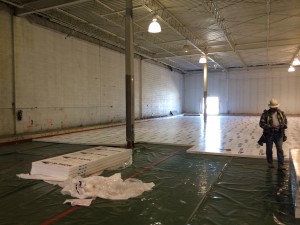Originally posted on Buildings Buzz blog by Insulfoam Marketing Manager, Becky Susan
Typically when it comes to thermal insulation, the goal is to keep heat in. Think, for instance, of insulating a school or office building so that the occupants stay warm while optimizing energy use. Nevertheless, many of the performance factors that influence insulation choice in such circumstances, also apply when the goal is to keep heat out. Examples range from large grocery warehouses to commercial wineries to institutional food storage spaces in schools and hospitals.
For insulating cold storage spaces, three important factors to consider are the insulation’s:
- Thermal performance
- Moisture performance
- Compressive strength
Paying attention to these three attributes will help ensure cost effective, high-performance insulation for any space that must be kept cold.
Thermal performance
All insulations are intended to block the flow of heat from warm areas to cooler areas, but materials vary widely in their thermal performance. In cold storage applications, rigid foams prevail for their high R-values, ability to provide continuous insulation, and durability.
Rigid foam options include expanded polystyrene (EPS) extruded polystyrene (XPS) and polyisocyanurate. While each material has its uses, EPS has the advantage of stable long-term R-values. Unlike other rigid foams, EPS manufacturers typically warrant the full R-value of their products during time in service. This is crucial, as insulations that become less effective over time contribute to higher energy costs, which is a major expense in operating a cold storage facility.
Moisture performance
Water is an excellent conductor of heat, so moisture reduces an insulation’s thermal performance. Think of wearing a wet stocking cap in the winter – you’ll end up with a cold head! As a result, when selecting insulation, it is crucial to consider the material’s moisture performance. For cold storage facilities, this is especially true for parts of the building envelope that will be exposed to high moisture, such as under concrete slabs and on foundation walls.
As with thermal performance, rigid foams differ in their moisture absorption. For example, an independent lab compared the moisture levels in EPS and XPS insulation buried side-by-side on the foundation of a Minnesota building for 15 years. The EPS moisture content was 5% compared to 19% for the XPS. This result was also born out in tests conducted by the U.S. Army Cold Regions Research and Engineering Laboratory (CRREL). The lab found that EPS buried in wetted soil for nearly three years absorbed only 1.7% moisture by volume.
Compressive strength
Because it is common to insulate beneath the floor slabs of cold storage facilities, understanding the compressive strengths of insulations is crucial for saving money. Notably, over-engineering the insulation can significantly increase material costs. In many cases a high compressive strength sub-slab insulation is not required, so a less expensive, lower compressive strength insulation can help manage the project budget.
The Albuquerque Public Schools experienced this in the development of a 108,000 sq. ft. central kitchen and food warehouse. The project team installed two layers of three-inch thick EPS in place of three layers of two-inch thick XPS, which saved approximately $20,000 in materials.
Choosing the right insulation is crucial in any building project, but especially so in cold storage facilities. In most buildings, sub-performing insulation results in higher energy costs and user complaints. As few people work inside cold storage spaces, a facility that’s too warm won’t cause anyone to complain, but can result in costly spoilage.


